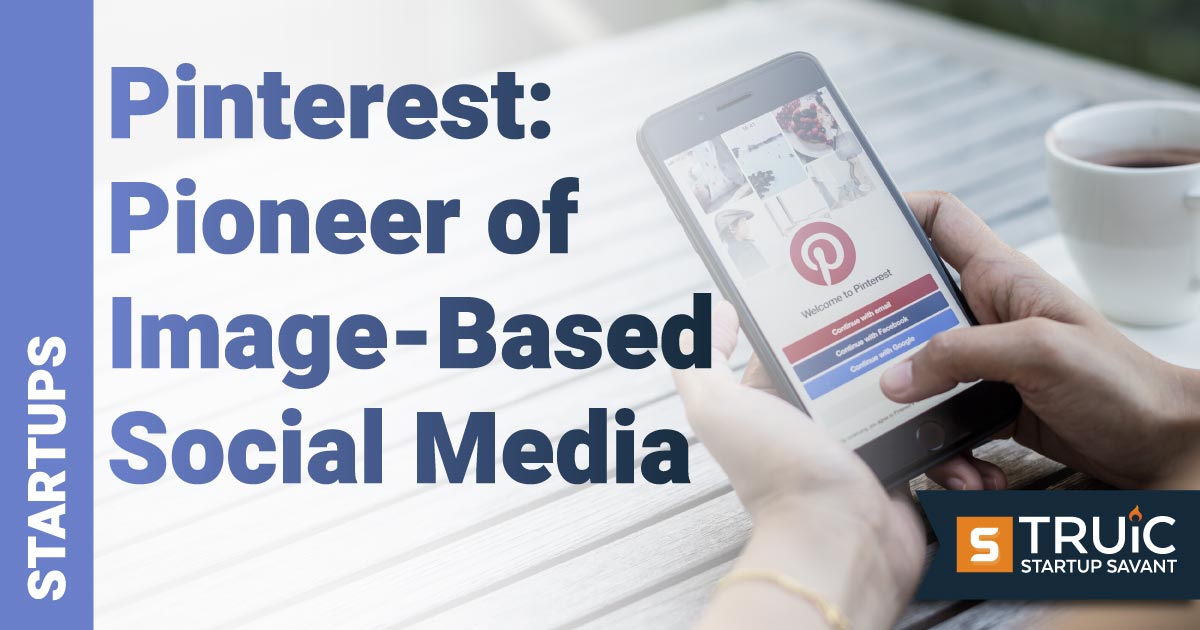Pinterest – Pioneer of Image-Based Social Media

Last Updated: By Madison Holt
Pinterest has become a household name, a go-to for anyone looking for a more visual social media experience than rivals like Facebook and Twitter. Some things are best conveyed in pictures – recipes, home decorating ideas, the latest fashions – and Pinterest is the place to post them.
In this series, we’re highlighting the origins, business models, marketing and growth strategies, and other key aspects of companies that successfully grew out of the startup phase to become global brands. Here is Pinterest’s story.
Pinterest Overview and History
Pinterest is a social media platform with a difference. While most social media centers around written comments, Pinterest allows people to create and post images, animated GIFs, and videos on specialized web pages called Pinboards.
This results in a different sort of communication – one that’s more visual, scannable, and engaging for certain types of content. For example, it’s easier to post an image of a great vacation spot, a new pair of shoes, or an informational graphic than to describe the same content in words.
The San Francisco, California-based company was founded in 2010 by Ben Silbermann, who formerly worked at Google. He and Paul Sciarra had previously developed an app called Tote that was supposed to replace paper catalogs. Tote never took off, in part because the mobile payment business was in its infancy at the time and didn’t allow users to easily make in-app purchases.
However, the app did plant the seeds of Pinterest. Tote users were actively sharing collections of favorite items with each other, and this inspired Silbermann to come up with another platform that would make collecting and sharing these items easier.
Pinterest launched as a closed beta in March 2010 and had about 10,000 users just nine months later. The iPhone launched in 2011, which made Pinterest more convenient to use and thus even more popular.
The platform grew rapidly after that and became one of the 10 largest social network services by December 2011, with some 11 million total visits per week. As of December 2021, Pinterest had a market capitalization of $23.3 billion, and some 431 million people use it every month.
Other Significant Events
Other significant events in the history of the company include:
- January 2012: named the “Best New Startup of 2011” by TechCrunch
- January 2012: Pinterest attracts 11.7 million unique US visitors, making it the fastest site ever to exceed 10 million
- April 2012: Pinterest wins “Best Social Media App” and “People’s Voice Award for Best Functioning Visual Design” at the 2012 Webby Awards
- February 2019: Pinterest secretly files for an initial public offering (IPO) of stock, according to The Wall Street Journal
- April 2019: The company goes public at $19 per share, closing the day at $24.40 per share
- March 2021: Pinterest reports advertising revenue of $1.7 billion in 2020 — up 48% from 2019
- December 2021: Pinterest acquires editing and video creation app Vochi, and shortly thereafter released a new streaming app that allows users to live-stream on its platform
- June 2022: The company announces that co-founder, CEO, and President Silberman would become Executive Chairman and online commerce expert Bill Ready would become CEO.
Pinterest Business Model
Like all social networks, Pinterest makes money from targeted advertising. However, due to the unique nature of the Pinterest platform, its method of doing so is a bit different from some of its competitors.
Personal Pinboards
Pinterest differentiates itself from similar websites in a couple of ways. First, it doesn’t allow users to share photos or other content with each other. Instead, users create personal Pinboards consisting of content they curate. This content can be information taken from the web, or it can be photos or videos uploaded by other people or the users themselves.
Another key difference is that Pinterest encourages its users to browse Pinboards (theirs or other people’s) to plan future endeavors like a vacation or craft project.
Perhaps more than any other platform, people use Pinterest for ideas and inspiration they wouldn’t find elsewhere. Pinterest’s visual nature can facilitate this sort of use better than a platform like Facebook that’s based primarily on the written word.
Moreover, a given Pinboard shows the most popular content about a particular subject from all over the web so that users can scan it easily in one place. This makes it easy to discover new information that might be missed otherwise.
Although some men use Pinterest, the vast majority of users are women. Pinterest users also have an above-average income, which makes the platform great for e-commerce efforts that might not do as well on other social media.
Promoted Pins
The primary way Pinterest makes money is by selling promoted Pins. Similar to Facebook’s Timeline, promoted Pins are almost (but not exactly) identical to user-generated Pins. Pinterest charges advertisers when users engage with promoted Pins. Alternatively, advertisers can select a cost-per-click (CPC) or cost per thousand (CPM) option.
“Our advertising products help businesses reach Pinners across their decision-making journey," the company said in an SEC filing. "We address various advertiser objectives through our Promoted Pin ad format, which contains either a single image, a carousel of images or video. Our ability to develop new and improve existing advertising products will be an important driver of our future growth."
Like Facebook and other social networks, Pinterest collects data from users that help it target promoted Pins based on what it thinks specific people would be interested in. The user data comes primarily from searches and interests, the latter being surmised based on demographics and the Pins that users post.
Monetized Pins
Another way that Pinterest makes money is by monetizing Pins. It does this by integrating a “buy it” button on a given Pin that lets users purchase items from Pinterest itself. This approach is different from (and can be more lucrative than) using affiliate links that go to third-party merchant websites.
Pinterest does have some corporate partners including Shopify, BigCommerce, and Salesforce, but the exact nature of these relationships is unknown.
Advantages of Pinterest to Advertisers
Because of how it’s structured, Pinterest offers advertisers some significant advantages.
- Visitor Intent: It’s easy to target users with a specific product or service on Pinterest because users express their intent through searches on the platform. If a product or service fulfills a user’s search intent, such as planning a wedding, he or she is more likely to engage with the ad.
- Re-Pinned Content. Users are likely to re-pin a particularly engaging or useful ad on multiple Pinboards, which will expand the ad’s reach.
- Visual Nature. Pinterest’s visual nature lends itself to building brand awareness with appealing, easily scannable content.
- Staying Power. While a Tweet or Facebook post can (and usually is) quickly forgotten, Pins – including Promoted Pins – tend to stay top of mind longer because of their visual nature.
Pinterest Marketing Strategies
According to marketing firm ReferralCandy, Pinterest has employed several marketing strategies at various times during its history, including:
- Utilizing word-of-mouth
- Targeting bloggers
- Encouraging users to be proud of their Pinboards
- Helping other companies market themselves
Utilizing Word-of-Mouth
Many of Pinterest’s first users naturally came from Des Moines, Silbermann’s hometown. His family and friends spread the word that there was a new images-based social media app they might want to try, and soon lots of people in the area were hooked.
However, after about three months, Pinterest couldn’t seem to attract more than about 3,000 users. So Silbermann decided to take a grassroots approach, organizing Pinterest-themed meetings at nearby business establishments and otherwise trying to build a community of serious Pinterest enthusiasts that would share their experiences with others and help market the company organically.
ReferralCandy says this strategy worked because most of Pinterest’s first users were people who like to do craft projects. These users typically were relatively social and hung out with other people who had the same hobby. They spread the word that Pinterest was helpful, and this proved to be a valuable marketing asset.
Targeting Bloggers
A second marketing strategy involved a campaign called “Pin it Forward” that targeted bloggers who assembled themed Pinboards and blogged about them. Other bloggers then linked to those posts and asked readers to incorporate the bloggers’ Pinboards into their own.
This strategy was particularly effective with DIY bloggers, as Pinterest lends itself to DIY projects. It allowed the company to transition from word-of-mouth marketing to internet marketing, thereby reaching a much wider audience.
Encouraging Users to Be Proud of Their Boards
More than other types of social media posts, Pinboards are often something their creators are proud of. They take time and effort to assemble, and the end product can be useful for a large number of people.
In addition, a well-curated Pinboard says something about the creator’s taste and knowledge of the latest trends. Pinboards can also serve as a creative outlet, allowing artists to share their art with a much wider audience than they otherwise could.
Finally, Pinboards offer a unique way to connect with others who have similar interests without having to create an artificial social media persona.
For all of these reasons, Pinterest knows that its users are keen to show off their Pinboards and encourages them to do so. This has turned out to be a great way to market the company.
Helping Other Companies Market Themselves
Pinterest realizes that it’s a great marketing tool for other companies. “Pinterest is the third-largest source of referral traffic on the internet and generates 400 percent more revenue per click than Twitter,” ReferralCandy says. “It’s transformed from ‘that app used by people who like arts and crafts’ into a powerful platform for marketers worldwide.”
When other companies use Pinterest for their marketing campaigns, this provides effective marketing for Pinterest itself. And when users share promoted Pins because they find them interesting, more people use the platform, and its user base grows.
What’s Next for Pinterest
Many market analysts are bullish on Pinterest’s future, noting several ways the social media platform is innovating. In fact, Pinterest reportedly spent $2.6 billion on research and development between 2019 and 2021 on new services. Services to be rolled out this year include:
- Your shop: Users will have their own customized shopping page that is based on their preferences, according to Pinterest's algorithm.
- Checkout: Users will be able to check out on Pinterest through a partnership with Shopify.
- Shopping API: Merchants will be able to sell their products and services on Pinterest directly with updated pricing, information on product availability, etc.
- Updates to the Pinterest Trends Tool: Real-time search data, additional audience tools, and other new features will help creators and merchants make more money on the platform.
These and other steps could increase revenue to about $3.5 billion by 2023 if they are implemented correctly and the company otherwise makes good decisions, analysts say. This is partly because its user base continues to grow.
In addition, much of Pinterest’s content relates to hobbies, ideas, and products that inspire users to buy things. This gives Pinterest an advantage over less consumer-focused platforms like Facebook.
Tell Us Your Startup Story
Are you a startup founder and want to share your entrepreneurial journey with our readers? Click below to contact us today!





